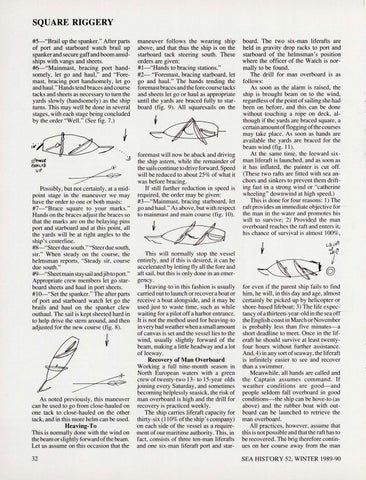SQUARE RIGGERY #5-"Brail up the spanker." After parts of port and starboard watch brail up spanker and secure gaff and boom amidships with vangs and sheets. #6-"Mainmast, bracing port handsomely, let go and haul," and "Foremast, bracing port handsomely, let go and haul." Hands tend braces and course tacks and sheets as necessary to turn the yards slowly (handsomely) as the ship turns. This may well be done in several stages, with each stage being concluded by the order "Well." (See fig. 7.)
;;7------47 Possibly, but not certainly, at a midpoint stage in the maneuver we may have the order to one or both masts: #7-"Brace square to your marks." Hands on the braces adjust the braces so that the marks are on the belaying pins port and starboard and at this point, all the yards will be at right angles to the ship's centerline. #8-"Steerduesouth.""Steerduesouth, sir." When steady on the course, the helmsman reports , "Steady sir, course due south." #9-"Sheetmain staysail and jib to port." Appropriate crew members let go starboard sheets and haul in port sheets. #10-"Set the spanker." The after parts of port and starboard watch let go the brails and haul on the spanker clew outhaul. The sail is kept sheeted hard in to help drive the stem around, and then adjusted for the new course (fig. 8).
maneuver follows the wearing ship above, and that thus the ship is on the starboard tack steering south. These orders are given: #!-"Hands to bracing stations." #2- "Foremast, bracing starboard, let go and haul." The hands tending the foremast braces and the fore course tacks and sheets let go or haul as appropriate until the yards are braced fully to starboard (fig. 9). All squaresails on the
foremast will now be aback and driving the ship astern, while the remainder of the sails continue to drive forward . Speed will be reduced to about 25% of what it was before bracing. If still further reduction in speed is required, the order may be given: #3-"Mainmast, bracing starboard, let go and haul." As above, but with respect to mainmast and main course (fig. 10).
This will normally stop the vessel entirely, and if this is desired, it can be accelerated by letting fly all the fore and aft sail, but this is only done in an emergency. Heaving-to in this fashion is usually carried out to launch or recover a boat or receive a boat alongside, and it may be used just to waste time, such as while waiting for a pilot off a harbor entrance. It is not the method used for heaving-to in very bad weather when a small amount of canvas is set and the vessel lies to the wind, usually slightly forward of the beam, making a little headway and a lot of leeway.
Recovery of Man Overboard
As noted previously, this maneuver can be used to go from close-hauled on one tack to close-hauled on the other tack, and in this more helm can be used.
Heaving-To This is normally done with the wind on the beam orslightlyforwardofthe beam. Let us assume on this occasion that the 32
Working a full nine-month season in North European waters with a green crew of twenty-two 13- to 15-year olds joining every Saturday, and sometimes becoming helplessly seasick, the risk of man overboard is high and the drill for recovery is practiced weekly. The ship carries liferaft capacity for thirty-six (110% of the ship's company) on each side of the vessel as a requirement of our maritime authority. This, in fact, consists of three ten-man liferafts and one six-man liferaft port and star-
board. The two six-man liferafts are held in gravity drop racks to port and starboard of the helmsman's position where the officer of the Watch is normally to be found. The drill for man overboard is as follows: As soon as the alarm is raised, the ship is brought beam on to the wind, regardless of the point of sailing she had b en on before, and this can be done without touching a rope on deck, although if the yards are braced square, a certain amount of flogging of the courses may take place. As soon as hands are available the yards are braced for the beam wind (fig. 11). At the same time, the leeward sixman liferaft is launched, and as soon as it has inflated, the painter is cut off. (These two rafts are fitted with sea anchors and sinkers to prevent them drifting fast in a strong wind or "catherine wheeling" downwind at high speed.) This is done for four reasons: 1) The raft provides an immediate objective for-the. man in the water and promotes his will to survive; 2) Provided the man overboard reaches the raft and enters it, his chance of survival is almost 100%,
for even if the parent ship fai ls to find him, he will, in this day and age, almost certainly be picked up by helicopter or shore-based lifeboat; 3) The life expectancy ofa thirteen-year-old in the sea off the English coast in March or November is probably less than five minutes-a short deadline to meet. Once in the liferaft he should survive at least twentyfour hours without further assistance. And,4) in any sort of seaway, theliferaft is infinitely easier to see and recover than a swimmer. Meanwhile, all hands are called and the Captain assumes command. If weather conditions are good-and people seldom fall overboard in good conditions-the ship can be hove-to (as above) and the rubber boat with outboard can be launched to retrieve the man overooard. All practices, however, assume that this is not possible and that the raft has to be recovered. The brig therefore continues on her course away from the man SEA HISTORY 52, WINTER 1989-90
